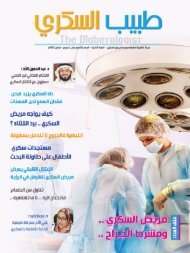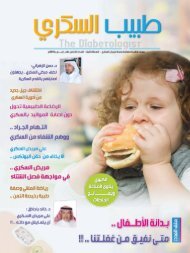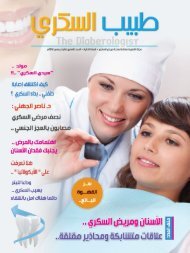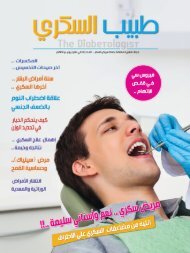The Diabetologist #24+25
طبيب السكري - العدد 24+25
طبيب السكري - العدد 24+25
You also want an ePaper? Increase the reach of your titles
YUMPU automatically turns print PDFs into web optimized ePapers that Google loves.
during uncontrolled hyperglycemia and glycosuria.<br />
<strong>The</strong>refore, the micronutrient effect may depend on<br />
the degree of glucose tolerance. Also, the micro<br />
nutrient effect on insulin secretion is biphasic. Low<br />
vitamin concentrations may stimulate insulin secretion,<br />
and high concentrations may have an inhibitory<br />
effect.53<br />
Advertisement<br />
In human studies, dietary micronutrient amounts are<br />
often unknown. To further confuse the micronutrient<br />
role and diabetes, serum or tissue content of certain<br />
elements -- copper, manganese, iron, and selenium<br />
-- can be higher in people with diabetes than in control<br />
subjects without diabetes. On the other hand,<br />
serum ascorbic acid (vitamin C), B vitamins, and vitamin<br />
D may be lower in individuals with diabetes,<br />
whereas vitamins A and E have been reported to be<br />
normal or increased.53<br />
Regardless, micronutrients are intimately involved in<br />
carbohydrate or glucose metabolism, insulin release,<br />
and insulin sensitivity. Unfortunately, this information<br />
is frequently extrapolated beyond what the research<br />
supports. <strong>The</strong> ADA recommends that individuals<br />
optimize food choices in meal plans to meet RDA<br />
and DRI intakes for all micronutrients.11,53<br />
ALCOHOL<br />
Earlier studies in T1D subjects showed no acute<br />
effect on blood glucose levels with moderate alcohol<br />
intake with meals. Further studies reported<br />
associations with late-onset hypoglycemia.54 Possible<br />
causes include inhibition of gluconeogenesis,<br />
reduced hypoglycemia awareness due to cerebral<br />
effects of alcohol, or impaired counterregulatory responses<br />
to hypoglycemia. A study with men with<br />
T1D who consumed wine in the evening (0.75 g alcohol/kg<br />
body weight; ~20 oz for a 70-kg individual)<br />
resulted in hypoglycemia treatment being required<br />
after breakfast.55 Growth hormone levels were significantly<br />
reduced, but no other differences in insulin<br />
or other hormone levels were reported. 55 Similarly,<br />
in T1D adults, hypoglycemia (blood glucose 50 mg/<br />
dl) resulted in lower peak growth hormone levels<br />
compared to placebo; however, this study was also<br />
associated with a decrease in insulin sensitivity.56<br />
In a study similar to the men’s wine study, T1D individuals<br />
drank either orange juice or vodka with their<br />
evening meal. Continuous glucose monitoring data<br />
showed that individuals who drank alcohol (0.85 g<br />
alcohol/kg body weight) had more than twice as<br />
many hypoglycemic episodes throughout the next<br />
24 h than those who drank orange juice.57,58<br />
In T1D subjects, both mild alcohol intoxication and<br />
hypoglycemia (blood glucose ~43 mg/dl) were associated<br />
with deteriorating reaction time and other cognitive<br />
function tests, and total impairment was greater<br />
when both were experienced together.59 <strong>The</strong> authors<br />
emphasized that individuals must test blood glucose<br />
levels before driving. <strong>The</strong>y should not drive when mildly<br />
hypoglycemic, even if asymptomatic.58<br />
Elevated total ketone body concentrations are characteristic<br />
of both diabetic ketoacidosis (DKA) and alcoholic<br />
ketoacidosis (AKA). However, compared to<br />
AKA, DKA is characterized by a higher glucose concentration<br />
and lower β-hydroxybutyrate:acetoacetate<br />
and lactate:pyruvate ratios. Hormonal profiles are similar<br />
with decreased insulin levels and elevated levels<br />
of counterregulatory hormones.60 T1D subjects who<br />
liberally consumed alcohol at lunchtime had elevated<br />
postprandial β-hydroxybutrate levels vs. suppressed<br />
levels with placebo.61 <strong>The</strong> authors propose that<br />
binge drinking may increase the risk of significant ketosis,<br />
especially with erratic insulin administration, and<br />
recommend that patient education materials highlight<br />
these potential problems.58<br />
Adolescents, in particular, must be instructed on alcohol<br />
and its potential hypoglycemic effects, and on responsible<br />
drinking. Adolescents who drive should be<br />
instructed on blood glucose monitoring before driving<br />
and on carrying a carbohydrate source with them at<br />
all times in case hypoglycemia should occur.<br />
In summary, moderate alcohol (one drink/day or less<br />
for women and two drinks/day or less for men) consumption<br />
appears to have minimal, if any, acute effects<br />
on glucose levels and insulin need, but patients must<br />
be aware of the occurrence of late-onset hypoglycemia,<br />
likely due to alcohol-related growth hormone<br />
reduction. Thus, alcohol should be consumed with<br />
food.13 Also, patients should repeatedly self-monitor<br />
blood glucose levels after drinking alcohol to assess<br />
if hypoglycemia treatment is needed. <strong>The</strong> additive effect<br />
of alcohol and hypoglycemia on cognitive function<br />
highlights the urgency of avoiding alcohol when<br />
planning to drive.58<br />
CARBOHYDRATE COUNTING<br />
Carbohydrate counting is a meal-planning method<br />
based on the principle that all types of carbohydrate<br />
(except fiber) are digested, with the majority being absorbed<br />
into the bloodstream as glucose molecules.<br />
<strong>The</strong> total carbohydrate consumed has a greater effect<br />
on blood glucose elevations than the specific type<br />
consumed. <strong>The</strong>re are two main methods of meal planning:<br />
an I:C ratio to adjust prandial insulin for variable<br />
carbohydrate intake (physiological insulin regimen) or<br />
02<br />
issue 24 - 25 < SEP./OCT. 2013

















